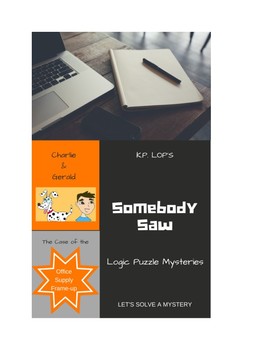Somebody Saw, Charlie & Gerald - The Case of the Office Supply Frame-up
Fostering Creative Genius
29 Followers
Grade Levels
1st - 9th, Homeschool
Subjects
Resource Type
Standards
CCSS2.OA.B.2
CCSS3.OA.A.2
CCSS4.OA.A.2
CCSS5.OA.A.2
CCSSHSA-REI.A.1
Formats Included
- PDF
Pages
12 pages
Fostering Creative Genius
29 Followers
Description
Beginning Level:
Mario is no thief. He definitely did not steal markers from the Principal. But someone planted the stolen markers in Mario's locker. Now Mario is in trouble.
Join Charlie and Gerald to analyze the clues and solve the crime.
What Makes a Student a Creative Genius:
1. Creative geniuses love puzzles. Tomorrow’s innovators need:
Imagination to approach tough problems and design new lines of attack.
Somebody Saw Logic Puzzles develop logical reasoning and deduction skills.
• Creative geniuses aren’t correct more often.
They’re more comfortable with failure and use it as inspiration for new ideas.
• Creative geniuses aren’t more knowledgeable.
They’re more flexible and able to make novel connections.
2. Creative geniuses have empathy. Tomorrow’s problem solvers need:
Compassion to become empowered conflict solvers.
Somebody Saw Logic Puzzles use stories of bullying to build understanding.
The Goal:
Everything is designed for success. Detailed videos walk through the solution of each puzzle. These can be used by teachers, parents or the students themselves.
For Teachers:
As a classroom activity, these puzzles generate powerful discussions. Students learn to form logical proposals and develop the flexibility and boldness to fail and try again. The stories of bullying encourage class discussions on creating kinder and safer environments.
For Parents:
Playing detective with your child is fun! And it can lead to sensitive and compassionate discussions about bullying and how children can protect themselves.
For Children:
Working independently can provide a student with the thrill of the chase, the satisfaction and focus that comes from delving into a mystery.
My Background:
As a Math and Physics teacher for over 25 years, I created puzzles for my students at many class levels. I have incorporated Next Generation Science Standards and Common Core Mathematical Standards into the puzzles to make them enriching and challenging.
Mario is no thief. He definitely did not steal markers from the Principal. But someone planted the stolen markers in Mario's locker. Now Mario is in trouble.
Join Charlie and Gerald to analyze the clues and solve the crime.
What Makes a Student a Creative Genius:
1. Creative geniuses love puzzles. Tomorrow’s innovators need:
Imagination to approach tough problems and design new lines of attack.
Somebody Saw Logic Puzzles develop logical reasoning and deduction skills.
• Creative geniuses aren’t correct more often.
They’re more comfortable with failure and use it as inspiration for new ideas.
• Creative geniuses aren’t more knowledgeable.
They’re more flexible and able to make novel connections.
2. Creative geniuses have empathy. Tomorrow’s problem solvers need:
Compassion to become empowered conflict solvers.
Somebody Saw Logic Puzzles use stories of bullying to build understanding.
The Goal:
Everything is designed for success. Detailed videos walk through the solution of each puzzle. These can be used by teachers, parents or the students themselves.
For Teachers:
As a classroom activity, these puzzles generate powerful discussions. Students learn to form logical proposals and develop the flexibility and boldness to fail and try again. The stories of bullying encourage class discussions on creating kinder and safer environments.
For Parents:
Playing detective with your child is fun! And it can lead to sensitive and compassionate discussions about bullying and how children can protect themselves.
For Children:
Working independently can provide a student with the thrill of the chase, the satisfaction and focus that comes from delving into a mystery.
My Background:
As a Math and Physics teacher for over 25 years, I created puzzles for my students at many class levels. I have incorporated Next Generation Science Standards and Common Core Mathematical Standards into the puzzles to make them enriching and challenging.
Total Pages
12 pages
Answer Key
Included
Teaching Duration
30 minutes
Report this resource to TPT
Reported resources will be reviewed by our team. Report this resource to let us know if this resource violates TPT’s content guidelines.
Standards
to see state-specific standards (only available in the US).
CCSS2.OA.B.2
Fluently add and subtract within 20 using mental strategies. By end of Grade 2, know from memory all sums of two one-digit numbers.
CCSS3.OA.A.2
Interpret whole-number quotients of whole numbers, e.g., interpret 56 ÷ 8 as the number of objects in each share when 56 objects are partitioned equally into 8 shares, or as a number of shares when 56 objects are partitioned into equal shares of 8 objects each. For example, describe a context in which a number of shares or a number of groups can be expressed as 56 ÷ 8.
CCSS4.OA.A.2
Multiply or divide to solve word problems involving multiplicative comparison, e.g., by using drawings and equations with a symbol for the unknown number to represent the problem, distinguishing multiplicative comparison from additive comparison.
CCSS5.OA.A.2
Write simple expressions that record calculations with numbers, and interpret numerical expressions without evaluating them. For example, express the calculation “add 8 and 7, then multiply by 2” as 2 × (8 + 7). Recognize that 3 × (18932 + 921) is three times as large as 18932 + 921, without having to calculate the indicated sum or product.
CCSSHSA-REI.A.1
Explain each step in solving a simple equation as following from the equality of numbers asserted at the previous step, starting from the assumption that the original equation has a solution. Construct a viable argument to justify a solution method.





